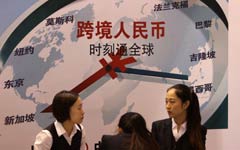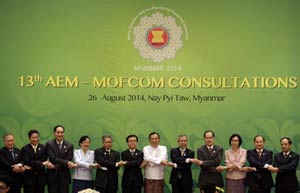China should consider setting up an integrated clearing facility with the Association of Southeast Asian Nations to further boost its trade and investment within the region, a top official said on Wednesday.
Cao Tong, vice-president of The Export-Import Bank of China, said the measure will also help popularize the use of renminbi as a trade currency within the region.
For countries such as Malaysia, Thailand and Singapore, which already have established clearing facilities, Beijing should seek easier linkages between the two systems to facilitate cross-border yuan transactions.

|
 |
"Regional economic integration cannot be achieved without building and improving financial infrastructure. A convenient and effective clearing platform will strengthen economic and trade ties within the region," Cao said.
Beijing has set a bilateral trade target of $1 trillion with ASEAN by 2020 and $500 billion by 2015, up from $443.8 billion in 2013. Having a higher proportion of trade settled in the yuan, instead of the dollar, will lower costs and more importantly strengthen financial ties with the region, which Beijing deems as a pillar of its diplomatic initiatives.
From January to August, 13 percent of China-ASEAN trade was settled in the yuan, lower than the 15.8 percent average in China's overall international trade in the same period.
As part of the move to enhance financial infrastructure in the region, the People's Bank of China has established currency swap lines with ASEAN countries including Thailand, Indonesia and Singapore.
Under Beijing's efforts, the yuan has already become one of the major trade currencies in the region. In a paper in 2012, Arvind Subramanian and Martin Kessler of the Peterson Institute for International Economics in Washington pointed out that "in East Asia there is already a yuan bloc, because the yuan has become the dominant reference currency, eclipsing the dollar, which is a historic development". Seven out of 10 currencies in the region could move more closely with the yuan than with the dollar.
To further yuan application in ASEAN, Cao said Beijing should grant quotas to ASEAN countries to raise the yuan for offshore for investment in the mainland.
Giving investors in the region more quotas under the Renminbi Qualified Foreign Institutional Investors program will encourage them to use the Chinese currency in more cross-border trade and investment and enhance the currency's sway within the region.
"ASEAN countries should be favored in terms of (RQFII) approval and the range of investment options under the program will help increase the amount of yuan deposits in the region," he said.
